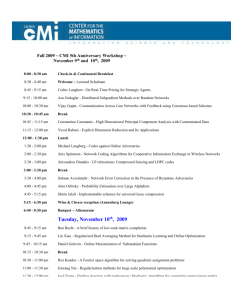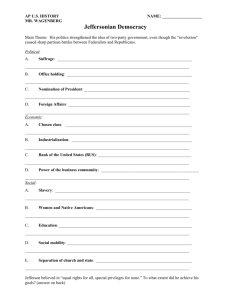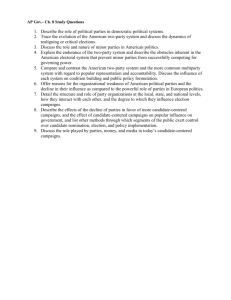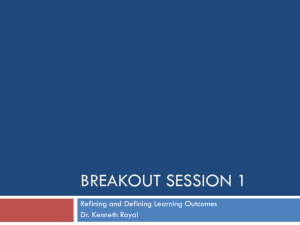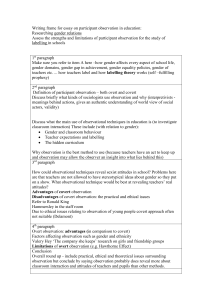PPT
advertisement
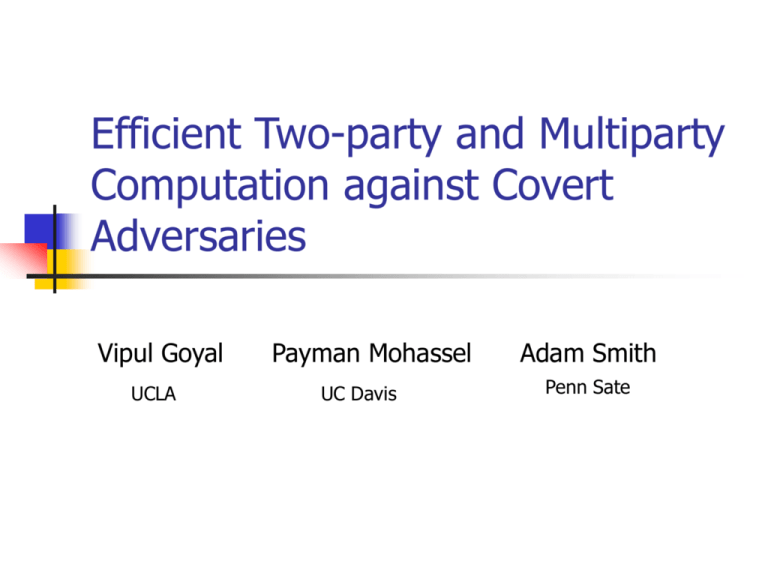
Efficient Two-party and Multiparty
Computation against Covert
Adversaries
Vipul Goyal
UCLA
Payman Mohassel
UC Davis
Adam Smith
Penn Sate
Secure Multiparty Computation
P2, x2
P1, x1
P3, x3
P5, x5
•
•
P4, x4
Parties learn f(x1,…,xn)
But no other information
2
Adversary Models
Number of corrupted parties
Honest majority
General adversary structures
Dishonest majority
No fairness or output delivery guarantee
Malicious vs. Semi-honest
Static vs. Adaptive
Covert Adversaries
Somewhere between malicious and
semi-honest
Adversary can cheat but,
Caught with reasonable probability
Detected cheaters are punished!
Studied in several previous works
[FY92], [CO99], [AL07], etc.
Covert Adversaries
Simulation-based definition [AL07]
TTP
anything
cheat
1- ɛ
x2
corrupted
x1
x2
malicious
honest
Covert Adversaries
TTP
anything
cheat
x2
x1
malicious
ɛ
x2
anything
x2
honest
Current Situation
Honest Majority
[DI05]
Constant Round
Blackbox reduction to PRG
Dishonest Majority
[IKLP06]
[KOS03]
Blackbox
Polynomial number of rounds
generic ZK
O(log(n)) rounds
[MF06,Woo07,LP07,JS07]
Constant round
No generic ZK
Only two-party case
Goal
Combine all the good properties
Round and communication efficiency
Avoiding generic ZK
Handle dishonest majority
Settle for Covert Adversaries
Contributions
Two-party Case
Improve communication
Malicious and covert adversaries
Multiparty Case
Avoids generic ZK
O(log(n)) rounds
Covert Adversaries
Two-party Overview
OTs for P2’s input keys
GC[1]
P1
t
GC[t]
Challenge e
Open all except for GC[e]
P2 evaluates GC[e]
P2
TWO-Party Improvements
Circuits generated pseudo randomly
Only hashes of circuits sent over
Seeds are revealed for opened circuits
Reduced OT communication
Only first few steps of OTs are executed
initially
Receiver committed to his inputs
Sufficient for simulation to go through
Two-party Improvements
h: hash function; G: PRG
s1 ← 1k , G(s1),
GC[1]← Garble(G(s1))
com(s1), com(h(GC[1]))
P1
P2
st ← 1k , G(st),
GC[t]← Garble(G(st))
com(st), com(h(GC[t]))
Challenge e
Reveal all seeds except se
Send GC[e], P2 evaluates GC[e]
Two-party Improvements
Communication
Undetected cheating prob. 1/t
O(|C| + t) instead of O(t|C|)
Can handle larger t
More incentive not to cheat
Malicious adversaries
Similar techniques work
Have not analyzed asymptotically
Multiparty Case
Modify [BMR90] garbled circuit
construction
Run the protocol in t session
Each session performed using
semihonest SFE
Perform cut-and-choose
Modified BMR
A mask bit λw for every wire w
Pi holds λiw
λw = λ1w λ2w ...
λnw
for Pi’s input bit xw let
xw
λiw
Two random keys kw,0, kw,1 for wire w
Pi holds kiw,0, kiw,1
kw,j = k1w,j || k2w,j || ... || knw,j
Modified BMR
Pi expands his keys to one-time pads
piw,0, qiw,0 ← G(kiw,0)
piw,1, qiw,1 ← G(kiw,1)
Garbled NAND gate g:
input wires a,b
output wire c
Modified BMR
g(0,0) =
p1a,0 …
pna,0 p1b,0 …
pnb,0
k1c,0 || … || knc,0 if λa NAND λb = λc
k1c,1 || … || knc,1
otherwise
xa
λa = 0; xb
(xa NAND xb)
g(0,1)
λb = 0
λc = (λa NAND λb)
g(0,0)
λc
g(1,0)
Similarly for g(0,1), g(1,0) and
g(1,1)
g(1,1)
Main Modifications
Inputs not embedded in garbled circuit
Opening a circuit does not reveal inputs
Garbling done using a semi-honest SFE
Parties commit to their random coins
Run multiple semi-honest sessions
Cheating is detected through cut-andchoose
Sub-Protocols
PublicCoinFlip
k
k
(1 ,…, 1 ) → (σ , …, σ)
[CR87, KOS03] O(logn) rounds
Simulatable Commitments
Commit: (σ;x1,…,xn) → ({com(xi)}, … ,
{com(xi)})
Open: Pi opens com(xi)
CommittedCoinFlipToAll
k
k
(σ;1 ,…,1 ) → (com(e), …, com(e))
CommittedCoinFlipToPi
k
k
(σ;1 ,…,1 ) → (com(e), …, e , … , com(e))
Main Protocol
CRS generation
σ ← PublicCoinFlip
Challenge generation
Com(e) ← CommittedCoinFlipToAll(σ)
Committing to randomness
For each player i, for each session S in [1..t]
- ri[S] ← CommittedCoinFlipToPi(σ)
- Expanded using pseudorandom generator
- used to generate mask bits, wire keys, semi-honest SFE randomness
Committing to Masked Inputs
Pi commits to xw
λiw[S] for his input wires w
Generating Garbled Circuits
Parties run t parallel sessions to generate garbled circuits GC[1], … , GC[t]
Verification Phase
Parties open the committed challenge e
For each session S ≠ e, parties open all commitments (except for masked inputs)
Evaluation Phase
For GC[e], parties open masked inputs and broadcast
Each party evaluates the garbled circuit on their own
Summary
Multiparty
Covert Adversaries
Avoid generic ZK
Round efficient
Two-party
Improved efficiency
Covert and malicious adversaries
Thank you!
Efficiency Measures
Communication
Rounds
Number of rounds of interaction
Computation
Number of bits exchanged
Local work by each party
Practical measures
Black-box use of underlying primitives
Avoiding generic ZK proofs
Efficiently implementable primitives
